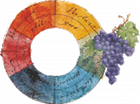For the fifth consecutive year, Viticolturabiodinamica.it organized the Modern Biodynamic Viticulture Conference in Cerreto Guidi, held with the support of the Municipality, the Superintendency, and the Province of Florence.
Once again, the project—conceived by Rita Mulas and with the scientific direction of Leonello Anello—successfully promoted dialogue among winegrowers, technicians, university professors and researchers, cultural and communication professionals.
As always, the sixteenth-century hall was fully booked. Participants, coming from various Italian regions and abroad, were welcomed by institutional greetings from Marilena Tamassia, Director of the Medici Villa of Cerreto Guidi, Mayor Carlo Tempesti, and Pietro Roselli, Agricultural Councillor of the Province of Florence. As usual, the heart of the event was the presentations, which illustrated the results of ongoing research and analyses specifically commissioned by Viticolturabiodinamica.it.
There were two international contributions: from Austria, Angelika Lübke-Hildebrandt, from United Research for Soil in Peuerbach, presented a talk titled Chromatography: history, practice, and interpretation of an analytical method that has revolutionized the approach to agronomic evaluation. She offered key interpretive tools for reading the revealing images of soil vitality, after a detailed introduction to high-quality compost management techniques.
From France, Margarethe Chapelle of Oenocristal Centre d’Évaluation et de Recherche Qualitative par Morphocristallisation, based in Puy L’Eveque, gave a presentation titled Investigations through sensitive crystallization of biodynamic, organic, and conventional wines from selected Italian producers. She delivered an in-depth analysis of blind tests conducted on wine samples sent especially for this edition of the Conference. The results—highlighted through striking images, for which Chapelle provided the essential interpretive parameters—demonstrated how this analytical method can reveal the past, present, and future of a wine, starting from the vineyard that gave it birth.
Among the Italian speakers was Vincenzo Romano Spica, Director of the Laboratory of Epidemiology and Biotechnology at the University of Rome “Foro Italico”, who discussed Analysis of mfDNA in soil treated with composted Preparation 500, presenting preliminary data from a study on the role of microflora and pointing to new avenues of research for modern biodynamics in relation to how the preparation can affect soil quality.
Leonello Anello, the soul of the Conference, an agronomist with over 25 years of experience in applying Steiner’s impulses and the developer of the Modern Biodynamic Method, followed up on the work presented the previous year. He delivered the second part of his study specifically focused on wine, within a broader framework dedicated to defining analytical and objective parameters for assessing the proper application of biodynamic practices in vineyards and winemaking.
In addition to the research presentations, there were two reports on the economic, social, and regulatory context of viticulture. Rita Mulas, Technical Director of the Conferences at the Medici Villa and Bauhaus Master San Vigilio Representative for integrated pilot projects for Expo 2015, presented From crisis to the rebirth of a territory, updating attendees on the state of initiatives aimed at restoring areas like Sulcis, severely damaged by reckless industrial development and land exploitation.
Fabrizio Lupi, official at the Florence office of the ICQRF – Central Inspectorate for the Protection of Quality and the Prevention of Fraud in Agro-Food Products, gave a detailed overview of the current labeling regulations for conventional, organic, and biodynamic wines. He also listened to numerous remarks from the attending producers regarding the gaps and ambiguities in the existing legislation.
The program continued with three follow-ups to presentations from previous years. Giancarlo Scalabrelli from the University of Pisa spoke about the distinctive organoleptic characteristics emerging from tastings of “i vini biodinamici”; Enzo Mescalchin from the Edmund Mach Foundation – IASMA presented updates on comparative research in Trentino vineyards managed under conventional, organic, and biodynamic practices; and Adamo Domenico Rombolà from the University of Bologna shared progress from studies, begun in 2008, on the effects of biodynamic preparations in a Sangiovese vineyard at a winery in Tebano, Romagna.
The Conference was coordinated by Marta Peloso on behalf of Viticolturabiodinamica.it.




